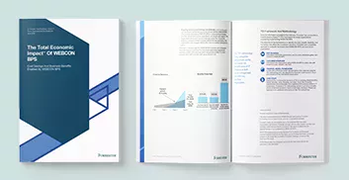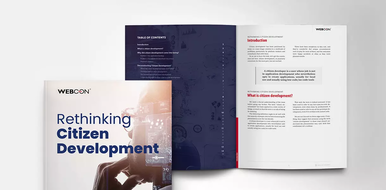Building and implementing a digital contract (agreement) management workflow with WEBCON BPS greatly helps improve Contract Lifecycle Management (CLM) in the organization, by streamlining the process of contract creation, negotiation, approval and signature collection. At the same time, it forms a secure digital repository that allows to reduce storage costs and enables faster access to documents, thanks to a quick search functionality.
The digital contract management workflow is primarily expected to improve the approval process of previously drafted documents. Meanwhile, a properly implemented application for Electronic Document Management workflow offers support at every stage of the contract lifecycle – from generating a legal agreement (based on a proper and up-to-date template), to implementing amendments as agreed with the client, all the way to collecting signatures – both digital and traditional.
The electronic version of a contract that is stored in the repository is not only easily accessible for authorized users, but its integration with ERP systems also enables it to initiate the invoicing process and serve as a point of reference for the account assignment of costs (cost invoice approval workflow).
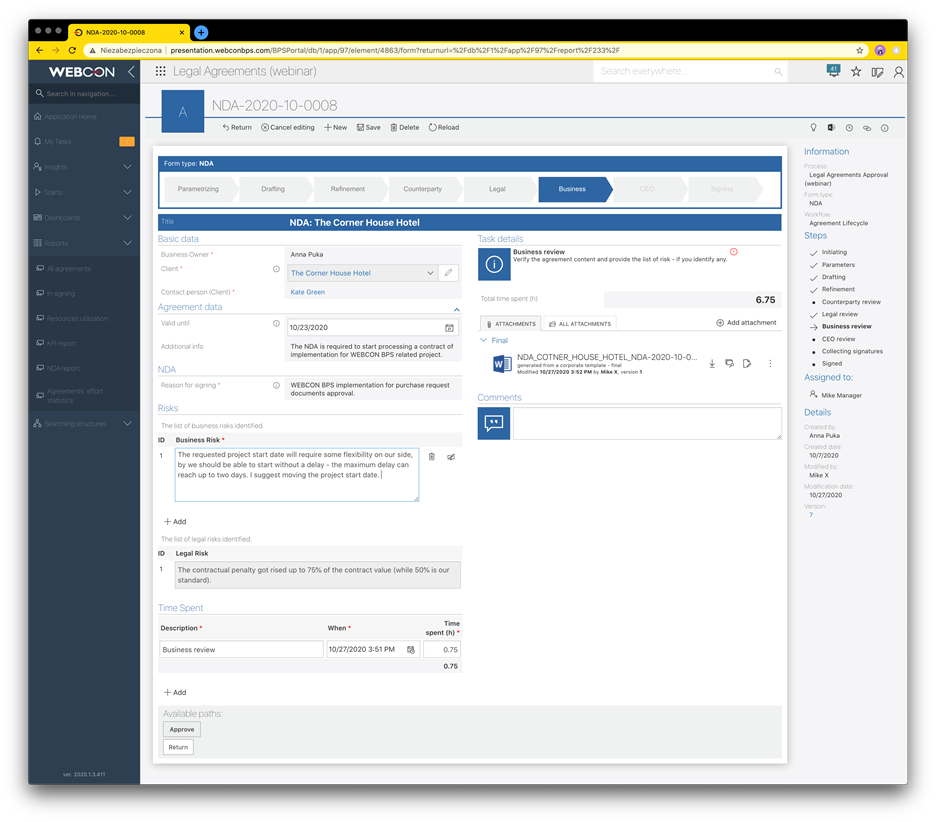

Digital contract management workflow in WEBCON BPS
The most common scheme for contract management workflow supported by WEBCON BPS includes:
- Beginning to draft an agreement – usually this step is launched intentionally by an employee with the appropriate authorization. However, sometimes the process can be started automatically, as a result of tasks performed as part of business processes within another IT system (e.g. as a result of the client’s approval of the proposed offer, withdrawal from an agreement sent via the Customer Service, or an intention expressed via a mailbox used for contacting clients).
- Determining the type of agreement and entering its parameters on a form – depending on the agreement type, different information is extracted (e.g. for NDAs, it will be the contractual penalty for a breach; for cost agreement, information on the various stages and schedule of payments) – these data will then be made available for reporting (e.g. will be used to determine the average value of contracts or contractual penalties for a given document type).
- Generating an agreement document based on the company’s existing template – the system extracts values from the form and automatically enters them into the agreement; it also allows for specific clauses and parts of the agreement to be conditionally generated, depending on the form content (e.g. the preamble is completed with client data from the CRM and/or the National Court Register), or on the business rules (e.g. paragraphs on confidentiality are only generated if there is no separate NDA between the parties already in place).
- Negotiating the content of an agreement with the client and with the involvement of the in-house legal department or a third-party law firm (under BPO) – the system constitutes a repository of exchanged files, monitors the correspondence between the process participants and generates a ‘redline’ version (comparing changes introduced from the moment the document is sent to the client until it is returned – including those implemented with the ‘track changes’ mode off) automatically (or ‘on demand’). All the while the system allows you to monitor the time spent on an agreement.
- Approving the agreement content and derogations from the template happens in accordance with the corporate approval matrix, and may take the form of a simple approval by a manager, legal department or the board, or the process may include the need to obtain approval for the draft agreement – e.g. from the line managers involved in performing and fulfilling the contractual obligations or cost center managers (a cost center, for purchase contracts, further allows the automated acceptance of costs and the assignment of invoices related to the agreement). At this stage, the system may generate a ‘redline’ of the original (template) agreement in order to properly identify all the derogations agreed upon at the negotiation stage. At the same time, it is possible to introduce a risk register (of both legal and business risks) related to signing the agreement, and to monitor the time spent on verifying the documents.
- Collecting signatures – the process can include signing documents with both traditional handwritten signatures, using mobile devices (just like confirming a parcel delivery with a courier), and via e-signatures (including qualified signatures – using dedicated tools, such as DocuSign, Adobe Sign, Autenti, Skribble and many others). Regardless of the selected method for collecting signatures, the system keeps the relevant people (e.g. assistants to the board) informed about the required actions and shows the agreement signature status in a transparent manner.
- Launching tasks that require performing, resulting from concluding the agreement, may be partly or entirely automated. If, as a result of signing an agreement, it is necessary to take specific steps (such as informing the relevant people, holding a meeting with a specific group, making a record in the IT system, etc.), the system will automatically send email notifications, assign tasks to be performed and confirmed by the user, or submit information to the appropriate system via Webservice. Thus, the process of concluding the agreement remains directly related to and coupled with the company’s actual business processes, by initiating or finalizing them.
- Digital document archiving – in special cases, and for authorized users, fast tracks for registering an already signed agreement are available, allowing to skip the steps of creation, negotiation and signing, and sometimes even the approval stage (e.g. when you are digitally archiving agreements that are already concluded). The system supports mass scanning of documents and OCR (Optical Character Recognition), which allows to easily search through the digital archives, using the key words and phrases that appear in the agreement’s content. For such registered agreement, it is also possible to complete the document’s metric (entering metadata describing the contract’s terms, based on the existing form template for a given contract type).
The digital contract management workflow can be easily developed and modified during the system implementation and maintenance, including the situation when the company is introducing changes to the procedures and organizational structure, even after the production launch of the solution.
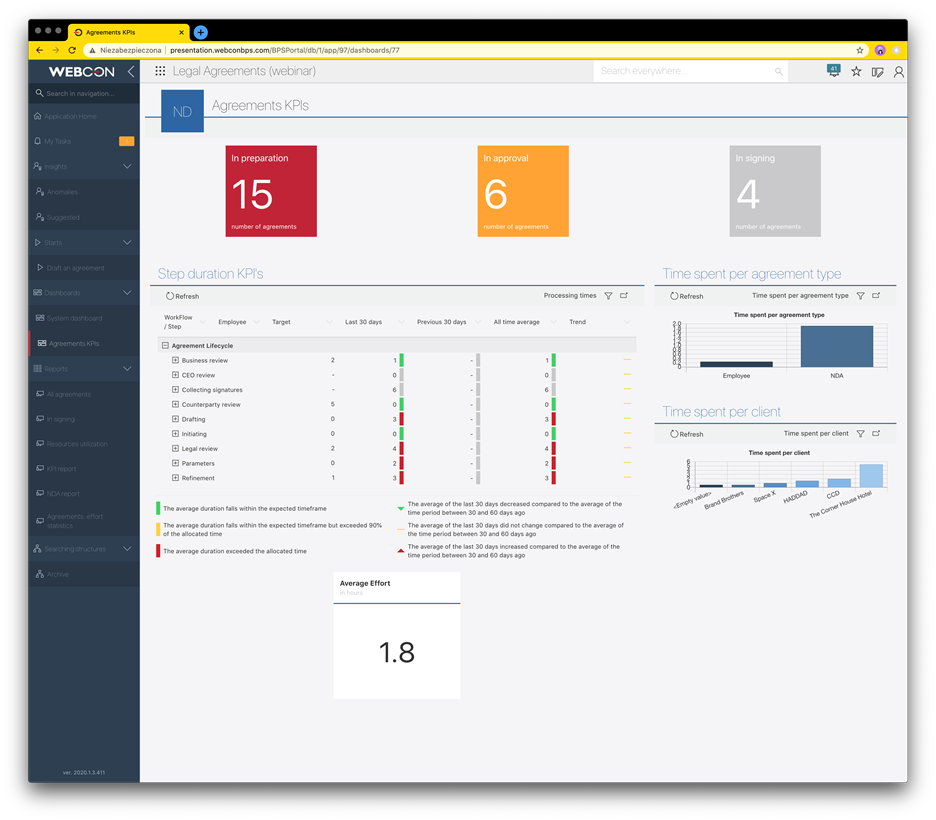

Key business benefits
The business benefits of implementing a digital contract management workflow built with WEBCON BPS include:
- Immediate availability of up-to-date agreement templates – employees don’t waste time on trying to find existing document templates, thereby eliminating confusion and risk resulting from working on the wrong template;
- Saving employee time thanks to automatic contract generation – the agreement template is completed with information (such as the counterparty data, agreement terms and conditional clauses) that are extracted from the form or external IT systems;
- Maintaining a full record of the performed tasks – every change introduced to the contract is saved in the system and made available for auditing (known as auditability);
- The automated process of ‘redline’ version generation – employees no longer waste time comparing subsequent agreement versions, and they can easily spot any changes introduced by the counterparties, thus reducing the company’s risk exposure;
- Speeding up the contract approval process, and making sure it’s being performed in line with company’s standards and procedures – employees do not need to know ‘who’s next’, as all the approvals are processed electronically, both in a browser and on mobile devices;
- The use of Artificial Intelligence helps to spot any anomalies during the agreement processing – significant deviation from average values for a given agreement type or situations that should not occur, like changing the counterparty at the contract approval stage;
- Automated and well-managed contract signing process is much faster than when being done manually, and at the same time is more transparent and secure;
- Availability of a digital contract archive – a safe document repository, that can be accesses only with appropriate authorizations - via a web browser or mobile devices;
- Time records of the work performed at the various stages of processing an agreement opens the doors to process optimization and better use of resources;
- A record of legal and business risks – it keeps the process transparent and enables maintaining a clear view of who’s responsibile for business arrangements and decisions made at the negotiation stage.
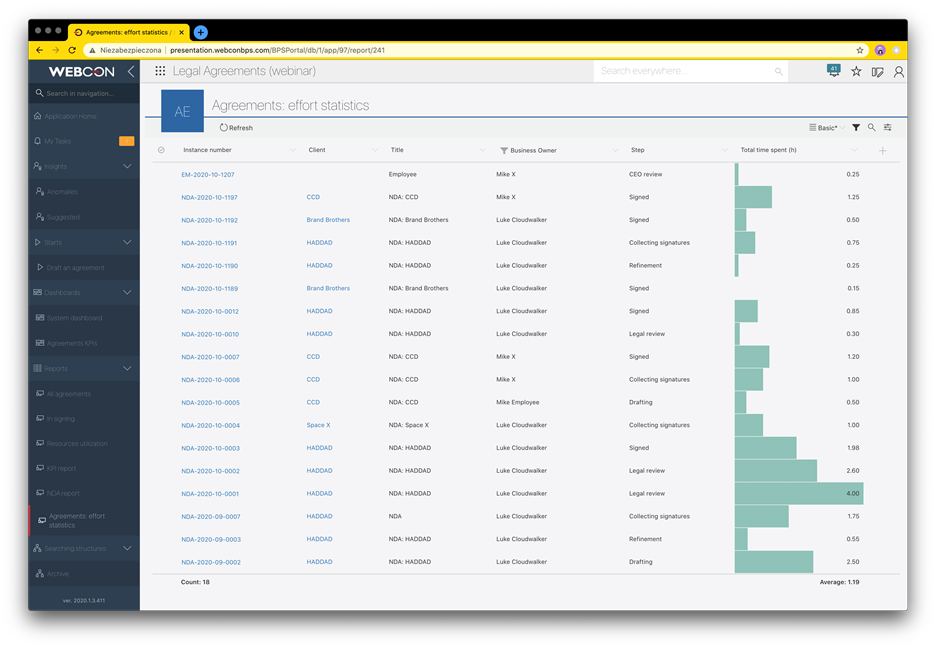

Key features and functionalities of WEBCON BPS
The following features and functionalities of the WEBCON BPS low-code platform are crucial for the implementation of the electronic document management workflow, including the contract management workflow:
- Handling barcodes to support the document scanning process (including batch scanning),
- The ability to model any agreement approval workflow, including multi-level conditional approval, taking into account the specific nature of a given agreement type and the company’s organizational structure,
- The ability to access the system and perform the tasks related to the contract approval process via a web browser or dedicated mobile app (Android, iOS), as well as within Microsoft SharePoint Online, Microsoft SharePoint Server, Microsoft Office 365, Microsoft Teams, and directly in Microsoft Outlook,
- The efficient handling of temporary substitutions and task delegation,
- Simple and fast modification of an existing workflow whenever contract approval procedures are changed is made possible thanks to our proprietary InstantChange™ technology,
- Transparent reporting on the agreements that are being registered and processed, with records of approvals and changes,
- Extensive reporting helps to spot bottlenecks and inefficiencies in the contract approval process, making it easier to introduce necessary changes in order to improve it.
- Integration with the company’s IT systems in order to use dictionaries (e.g. ERP’s dictionary of the third-party suppliers) and to fill in the agreement parameters,
- Built-in scalability allowing the system to handle large volumes of data and large numbers of employees (even over several thousand people),
- Possibility to further developing the digital contract management workflow by adding other related processes, such as counterparty registration and validation, payment processing, invoicing orders, including acceptance of recurring cost invoices, etc.







